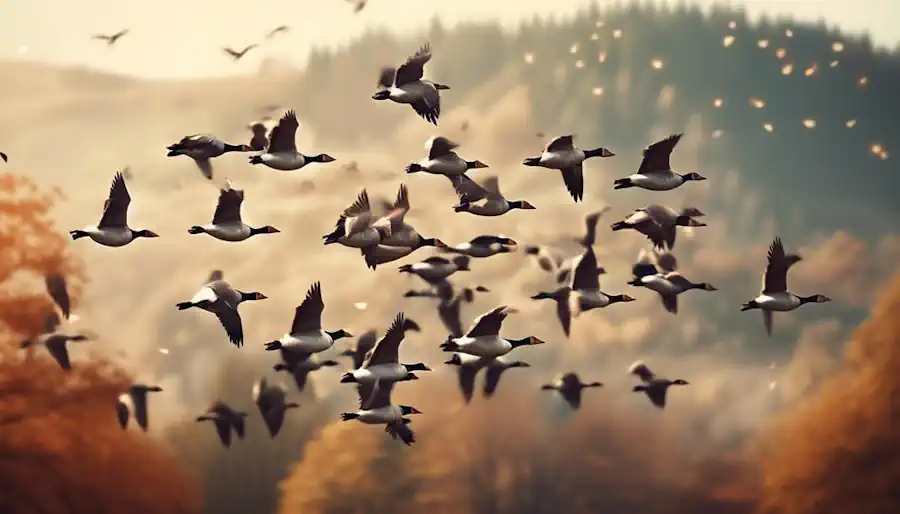Have you ever thought about how birds can fly for thousands of miles and land exactly where they need to be? It’s pretty amazing.

Every year, many kinds of birds take on big trips across tough landscapes, yet they seem to know exactly where to go. Researchers have found out that birds have several ways to find their way, like using the stars and the Earth’s magnetic field. But there’s still a lot we don’t understand about how they do it.
When you look up at the sky, just think about the incredible skills these birds have for navigation that we haven’t fully figured out yet.
Let’s make it simpler to understand. Birds go on long trips and can find their way as if they had a map in their heads. They use the night sky and the magnetic lines of our planet to guide them. This is important because it shows how smart and adapted birds are for survival. These trips can be dangerous, but birds seem to have a built-in system to help them.
For example, the Arctic Tern travels from the Arctic to the Antarctic every year, which is like going from the top of the world to the bottom! Scientists are still trying to learn all the secrets of how birds do this. When we look at birds flying, we should remember that there’s a lot of cleverness in their simple act of migration.
Innate Instincts and Learned Behaviors
Birds naturally know when to start their long journey to warmer or cooler places, depending on the season. This is because they react to changes in the environment like temperature and daylight. However, they also learn from the older birds in their group how to find their way. Young birds watch and follow the older ones, which helps them survive and travel far.
These birds use the Earth’s magnetic field to help them know which way to go, like a built-in compass. But this can be messed up by things humans do that change the magnetic field. That’s why research to learn more about this problem and how to fix it is really important. We can help these birds by doing things that make their travel safer.
For example, we can turn off lights at night in big cities during migration season. This helps because birds can get confused by the lights and have a hard time seeing the natural signals they need to follow. We can also avoid using chemicals that might hurt their sense of direction. By making these changes, we can make a big difference in the lives of these amazing travelers.
Celestial Navigation Techniques
Migratory birds are experts at finding their way over long distances. They use the sun and stars to navigate, like using a map that’s built into their brains. Birds have a natural sense of time that helps them understand the sun and stars’ movements as the seasons change.
Birds can also sense the Earth’s magnetic field, which helps them know which way is north and south, almost like they have a built-in compass. They even use their sense of smell to recognize landmarks. The way birds navigate is a key part of how they’ve survived and thrived over time.
Here’s how it works: As the positions of the stars and the sun shift with each season, birds adjust their routes. This means they always know the best way to go, no matter the time of year. For example, they might follow the North Star in one season and use the position of the sunrise or sunset in another.
The Earth’s magnetic field is another tool birds use. Just like a hiker uses a compass to find their way, birds can detect the magnetic field to stay on their path. This is especially useful on cloudy days when the stars or the sun might be hidden.
Birds’ sense of smell is like having a set of landmarks only they can detect. This helps them recognize areas they’ve visited before, which can guide them to their destination.
All these skills combined show just how amazing birds are at navigating. They can fly thousands of miles and end up in the exact place they need to be. This is crucial for their survival, as it helps them find food, escape harsh weather, and raise their young in the best possible locations.
Magnetic Field Compass Mechanism

Birds have a special skill that lets them sense the Earth’s magnetic field, which they use like a compass to guide them over long distances with amazing precision. This natural compass is crucial for their migration, helping them to find their way to the places where they breed and spend the winter. This ability to detect magnetic fields helps birds figure out which way to go and stay on track, even if they get moved from their usual path.
Here’s a simple breakdown of how this works:
- Magnetic Sensing: Birds pick up on the Earth’s magnetic field lines, which helps them know which direction they’re facing.
- True Navigation: They can pinpoint their exact location, which means they don’t get lost during their long trips.
- Innate Ability: Birds are born with the know-how to navigate, so they don’t have to learn it by making mistakes.
- Seasonal Movement: They move between living areas depending on the time of year, linking the places they breed with where they spend the colder months.
Because birds use this magnetic field compass system, they do a lot of good for the places they visit. They help keep nature in balance by spreading seeds, controlling insect populations, and being part of the food chain. For example, when birds migrate, they might eat pests that harm crops, benefiting farmers and the environment.
Landmark Route Guidance
Birds are like expert travelers, using the Earth’s natural features to find their way during long flights. Just as people might use landmarks like mountains or lakes to navigate on a road trip, birds look for similar things from the sky. They pay special attention to big landmarks, such as mountain ranges, coasts, and large bodies of water, to guide them. These landmarks are especially helpful when birds are close to their destination, acting like signposts that tell them they’re almost there, especially after flying for so long over areas that all look the same.
From the first time they migrate, birds naturally learn to spot and remember these important places. They don’t just rely on landmarks, though. As mentioned before, they also use the stars and the Earth’s magnetic field to help them know where they’re going, like a built-in GPS system.
By studying how birds use these natural signs, we can better understand how amazing their sense of direction is. This knowledge is also really important for keeping bird migration paths safe and making sure they can always find their way.
When we talk about how birds migrate, we’re not just saying they have a good sense of direction. We’re recognizing that they have a complex way of navigating that’s hardwired into them from the start. It’s fascinating and it shows us just how important it is to protect the environments they rely on to guide them on their journeys.
Scent and Social Learning

Birds use their sense of smell to find food and water, which is crucial for them to survive their long trips when they migrate. But there’s more to it than just following scents. Young birds hone their ability to fly across large distances by watching and copying what the older birds do. This way, each new group of birds knows exactly where to go.
Why does this matter? It’s because scent and learning from others are key parts of how birds find their way during migration. When you watch these birds, you see that they don’t just act on instinct. They’re smart and can adjust to new situations. This helps them get to their goal and makes sure their species continues to thrive.
To put it simply, birds have a smart way of using smells and learning from each other to make their difficult journeys successful. They pick up on changes in their environment and use what they learn to keep doing what’s best for their group. This combination of skills is what helps them find their way year after year.
Final Thoughts
You’ve traveled with the birds, understanding how they use their natural sense of direction, the stars, the Earth’s magnetic field, visible landmarks, and smells to find their way.
As you now know, these sky travelers, much like the sailors of old who relied on the stars, are facing new challenges. City lights and the many electronic devices in our world today can interfere with their traditional migration routes.
It’s very important to realize that protecting the paths birds take when they migrate isn’t just about being amazed by them. It’s about maintaining the balance of nature, where the flight of each bird matters.
